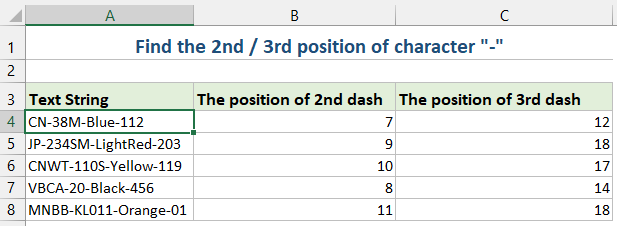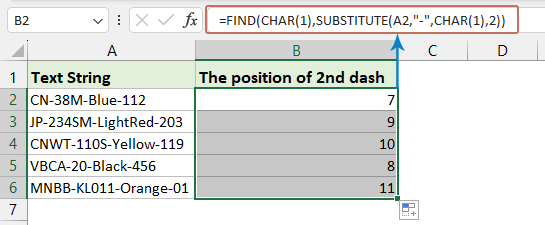Vind de zoveelste keer dat een teken voorkomt in Excel – 3 snelle manieren
Het vinden van de zoveelste keer dat een specifiek teken voorkomt in een tekstreeks in Excel kan met name handig zijn bij gegevensanalyse, waarbij u tekenreeksen mogelijk moet parseren of informatie moet extraheren op basis van bepaalde scheidingstekens of patronen. Laten we bijvoorbeeld de tweede of derde keer zoeken dat het teken "-" voorkomt in een tekstreeks. Ik zal eenvoudige technieken demonstreren om deze taak efficiënt uit te voeren.

Vind de zoveelste keer dat een teken in een tekstreeks voorkomt met de formule
U kunt een formule opstellen om het zoveelste voorkomen van een teken te vinden. Doe het als volgt:
1. Voer de volgende formule in of kopieer deze naar de cel waar u het resultaat wilt krijgen:
=FIND(CHAR(1),SUBSTITUTE(A2,"-",CHAR(1),2))- A2: De cel die de tekenreeks bevat.
- -: Het personage dat je zoekt.
- 2: Het tweede exemplaar dat u wilt vinden, kunt u naar behoefte wijzigen in 2.
2. Sleep vervolgens de formulevulling naar beneden om de formule naar andere cellen te vullen, en de tweede positie van het teken wordt in één keer weergegeven, zie screenshot:
- PLAATSVERVANGER vervangt de zoveelste keer dat het teken voorkomt door een niet-afdrukbaar teken (CHAR(1)).
- VINDEN zoekt naar dit niet-afdrukbare teken en geeft de positie van het zoveelste exemplaar weer.
Vind het zoveelste exemplaar van een teken in een tekstreeks met Kutools voor Excel
Als je geen fan bent van het gebruik van formules of VBA, kun je een handig alternatief overwegen: Kutools for Excel. Binnen de Formule-groepen vindt u een handig hulpprogramma: Zoek waar het teken N-de in een tekenreeks voorkomt die snel de n-de positie van elk teken in een cel identificeert en retourneert.
Na het installeren van Kutools voor Excel, Klik Kutools > Formule Helper > Formule Helper om de te openen Formule Helper dialoog venster. Klik op een cel waar u het resultaat wilt plaatsen. Doe het dan als volgt:
- kies Lookup uit de vervolgkeuzelijst van Formule type sectie;
- Kies Zoek waar het teken N-de in een tekenreeks voorkomt in Kies een formule sectie;
- Selecteer de cel die de tekenreeks bevat die u gebruikt en typ vervolgens het opgegeven teken en de zoveelste instantie in de tekstvakken in de Argumenten ingevoerd sectie;
- Eindelijk, klik OK knop om het resultaat te krijgen.

Vind de zoveelste keer dat een teken voorkomt in een tekstreeks met de door de gebruiker gedefinieerde functie
In deze sectie onderzoeken we hoe u een UDF kunt maken en gebruiken om de zoveelste keer dat een teken voorkomt in Excel te vinden, en bieden we een stapsgewijze handleiding om u te helpen uw gegevensverwerking te optimaliseren.
- Houd de toets ingedrukt ALT + F11 toetsen, en het opent de Microsoft Visual Basic voor toepassingen venster.
- Klik Invoegen > Moduleen plak de volgende macro in het modulevenster.
Function FindN(sFindWhat As String, _ sInputString As String, N As Integer) As Integer 'Updateby Extendoffice Dim J As Integer Application.Volatile FindN = 0 For J = 1 To N FindN = InStr(FindN + 1, sInputString, sFindWhat) If FindN = 0 Then Exit For Next End Function - Sluit vervolgens het vba-venster. Ga terug naar het werkblad, voer de volgende formule in een cel in en sleep vervolgens de vulgreep naar beneden om de formule naar andere cellen te vullen, zie screenshot:
=FindN("-",A2,3)
- Tel het aantal keren dat een woord in een kolom voorkomt
- Als u kolomgegevens heeft die enkele dubbele waarden bevatten, zoals onderstaand screenshot, en wat u nu wilt doen, is het aantal keren tellen van een specifiek woord in deze kolom. Nu met deze tutorial introduceer ik enkele trucs om het snel op te lossen in Excel.
- Vervang het eerste n teken of het nde voorkomen van een teken door een ander
- In Excel vinden en vervangen we een tekenreeks meestal door de functie Zoeken en vervangen, maar als u zich in een van de onderstaande gevallen bevindt, kan de functie Zoeken en vervangen u niet helpen.
- Extraheer een n-de teken uit een string
- Over het algemeen wil je misschien een string extraheren na een specifiek teken, maar in dit geval wil ik het n-de teken uit een string extraheren, zoals hieronder wordt getoond.
- Extraheer de eerste/laatste n tekens uit de tekenreeks
- Er is bijvoorbeeld een lijst met lange strings in elke cel en u wilt alleen de eerste n tekens uit elke tekenreeks extraheren, zoals de eerste 3 tekens van elke tekenreeks, en nu kunt u de volgende methoden gebruiken om het in Excel op te lossen .
Gerelateerde artikelen:
Beste Office-productiviteitstools
Geef uw Excel-vaardigheden een boost met Kutools voor Excel en ervaar efficiëntie als nooit tevoren. Kutools voor Excel biedt meer dan 300 geavanceerde functies om de productiviteit te verhogen en tijd te besparen. Klik hier om de functie te krijgen die u het meest nodig heeft...

Office-tabblad Brengt een interface met tabbladen naar Office en maakt uw werk veel gemakkelijker
- Schakel bewerken en lezen met tabbladen in Word, Excel, PowerPoint in, Publisher, Access, Visio en Project.
- Open en maak meerdere documenten in nieuwe tabbladen van hetzelfde venster in plaats van in nieuwe vensters.
- Verhoogt uw productiviteit met 50% en vermindert honderden muisklikken voor u elke dag!
